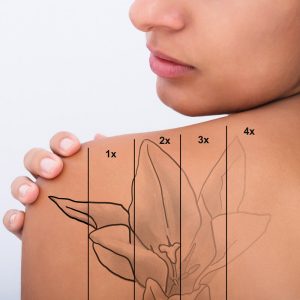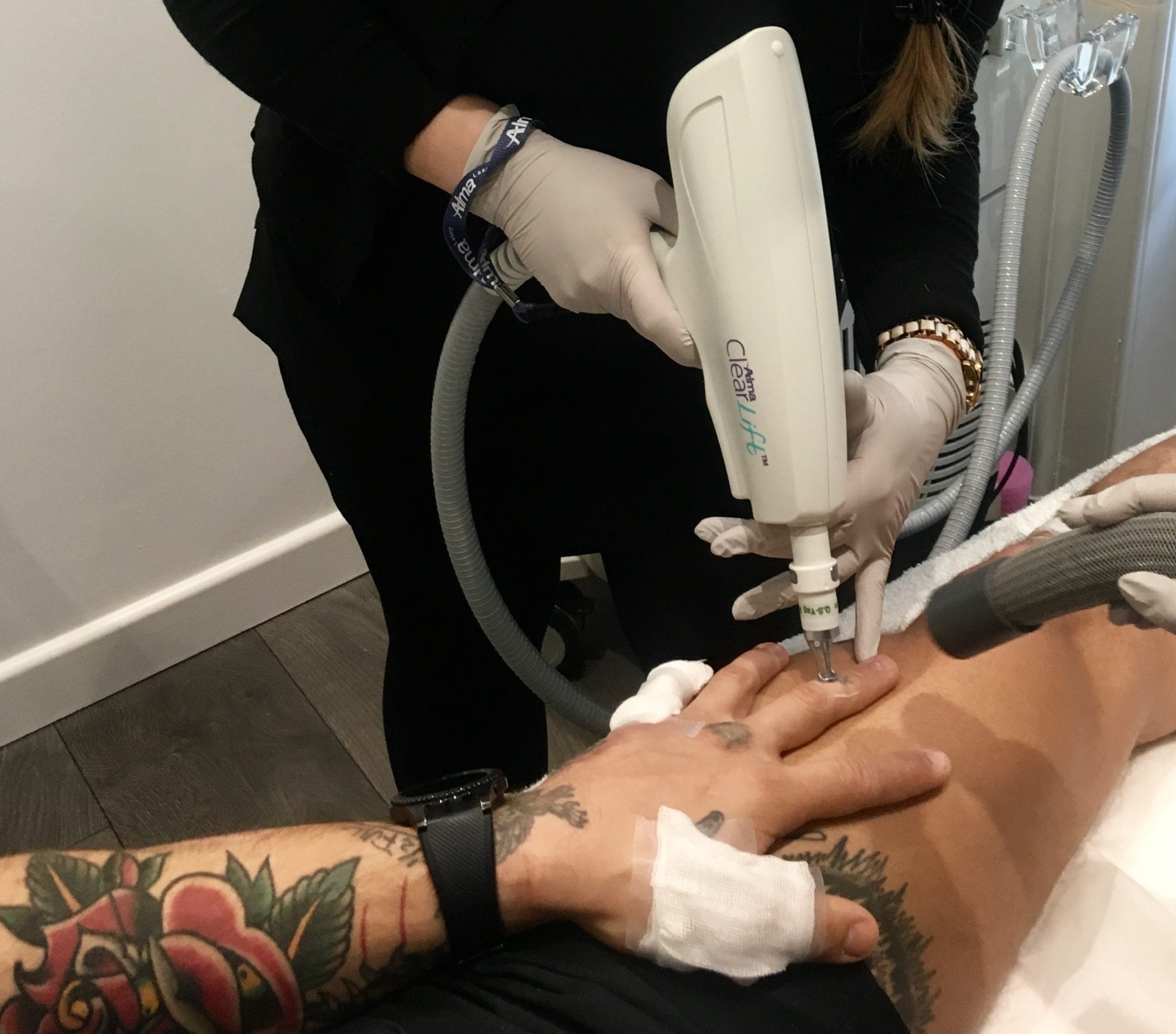Do you have a tattoo that you regret and want it removed for good? Pulse Laser Aesthetic Clinic specialises in removing tattoos of all sizes and colours with our state-of-the-art Q-switched ND:YAG laser from Alma Lasers. This laser is a non-invasive treatment can safely remove your tattoo, whilst minimizing the risks of scarring or loss of skin colour (hypopigmentation). For any questions and to speak to a member of our team contact our London Laser Tattoo Removal Clinic on 020 3405 8483 or via info@pulse-clinic.co.uk.
Laser Tattoo Removal

We apply powerful Photo-Acoustic laser energy, with very short pulses, to the unwanted tattoo. These pulses penetrate through the top layer of skin and shatter the tattoo ink into tiny fragments, without causing damage to the skin. Over time, your body’s natural healing processes (the lymphatic system) remove the ink fragments from your body. This allows your tattoo to fade with only minimal risks of scarring or skin discoloration.
Every colour of ink requires a different wavelength of light and amount of energy to be efficiently removed. At Pulse Laser Aesthetic Clinic, our high-powered Q-switched laser that can operate at two different wavelengths to be effective with darker colours (blacks and blues, 1064nm), as well brighter colours, like red and orange (532nm).
Before your first session, you will attend a complimentary consultation and patch test appointment where the technician will test your skin’s reaction to the laser to determine the most effective energy for treatment.
For the treatment, you will be given a pair of protective eye shields. If your tattoo is large, numbing cream may be applied beforehand. The technician will also cool your skin with a CryoAir, a powerful chilling machine that blows cold air on the skin. This will keep the skin cool whilst they use the laser to pass pulses of intense light over the tattoo. Smaller tattoos will require fewer pulses, and this will take as little as 5 minutes, while larger ones will need more pulses and time to remove them.
Immediately following the treatment, a soothing cream and dressing will be applied to the treated area to protect it and after care advice will be given.
To discuss your personal laser tattoo removal treatment plan and for any other questions you may have, contact our clinic on 020 3405 8483 or via info@pulse-clinic.co.uk to book your appointment today.
How much does Laser Tattoo Removal cost?
The cost of each session depends on the size of the tattoo (or tattoos) being
removed, with prices starting from £50 per session. We will price each session during the free consultation by categorising your tattoo according to its size. We offer discounts for buying a course of treatments in advance. For more information see our price list page.
How long will it take to remove my tattoo?
The number of sessions needed to remove a tattoo depends on three factors:
the age of the tattoo,
the colour of the ink, and
the density of the ink.
During a free consultation, our experienced practitioners will discuss the number of treatments you are likely to need. Usually this ranges from 4-12 treatments.
How much time is left between sessions?
To allow the skin enough time to heal between treatments and the body’s immune system to flush away ink, we recommend a minimum of six weeks between laser
sessions – and eight weeks for darker complexions. Stacking the treatments too
close together can cause damage and permanent side effects to the skin and doesn’t allow the body enough time to remove the ink that was shattered at the most recent session. For ideal results, we recommend waiting three months between treatments.
Does tattoo removal hurt?
Laser tattoo removal involves some level of discomfort; however we can reduce the discomfort by applying a numbing cream. We also conduct the treatment together with a CryoAir, which is a powerful chilling machine that blows cold air on the skin before, during, and after treatments. This soothes the skin and makes the treatment very tolerable. We apply a soothing gel to the treated area after the treatment.
Will it leave a scar?
If the tattoo already features scarring, expect that to remain. Any scarring that
remains after a tattoo removal procedure is often left over from when the tattoo was originally applied by the tattoo artist. It is very uncommon for a patient to scar
from a laser treatment provided the correct aftercare procedure is followed. We can use a fractional laser (such as our iPixel laser) to resurface scarred skin caused from the application of the tattoo, after the tattoo removal process.
Can you help me revise this tattoo?
Yes, we can provide support to patients looking for tattoo revision rather than completely removing the whole tattoo.
How does laser tattoo removal work?
Each pulse of the laser sends light energy into your skin. We use different
wavelengths of laser light to treat different colours of ink in your tattoo. As the light energy is directed into your skin, it is selectively absorbed by the tattoo ink particles trapped in the dermis of your skin. When the ink particles absorb this energy, they instantly shatter into tiny fragments. Once the laser has broken the ink into smaller pieces, your body’s immune system works to remove the ink over the following weeks, flushing it away from the tattooed area. We see the result of this as the tattoo lightening in appearance. Each additional laser treatment breaks down more and more ink until the tattoo can no longer be seen.
How do I prepare for my laser tattoo removal treatment?
We recommend that you avoid excessive sun exposure 2 weeks before the treatment starts and avoid taking any photosensitive medication. If you are unsure about a medication, please contact the clinic for advice. You will also be required to shave any hair surrounding the tattoo.
What aftercare will I need?
For the week after the treatment session, you should:
wash and dry the treated area gently using a mild soap, then apply a thin layer of vaseline or other occlusive.
protect your skin with high factor sunscreen
avoid excessive UV exposure
avoid strenuous exercise



For further information or to speak to a member of our team please contact us.
